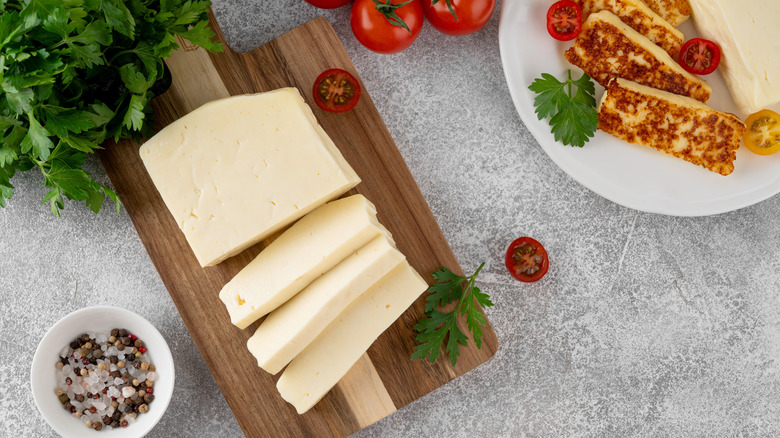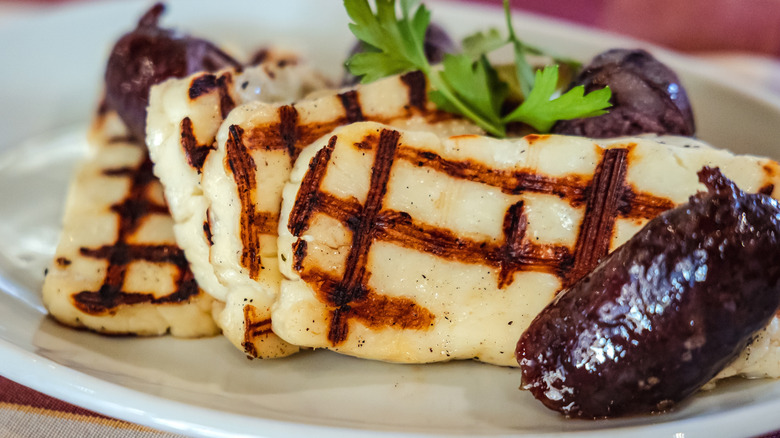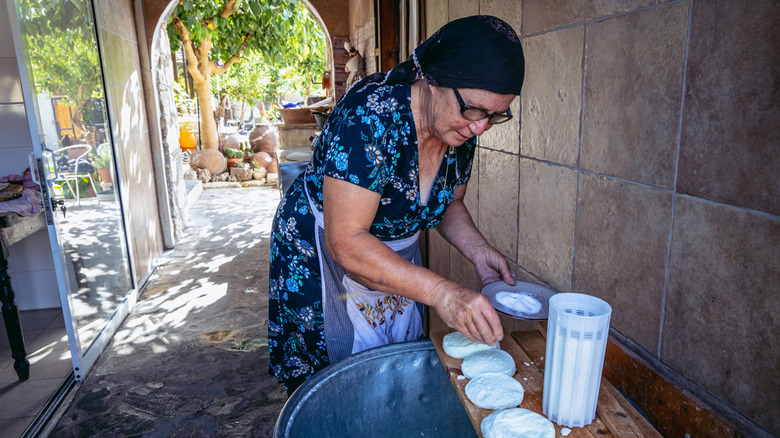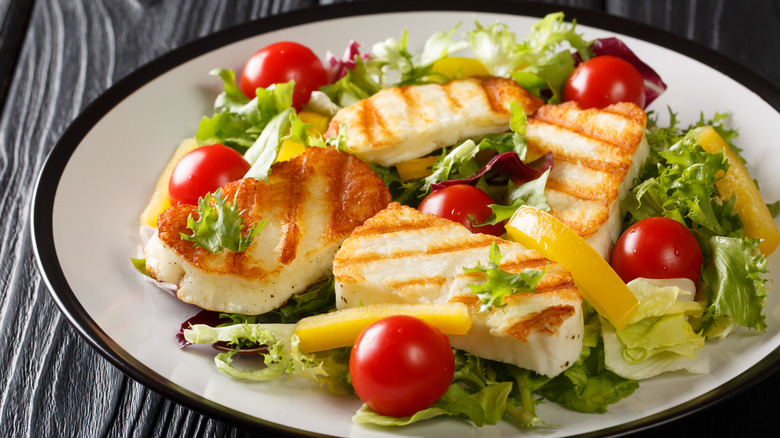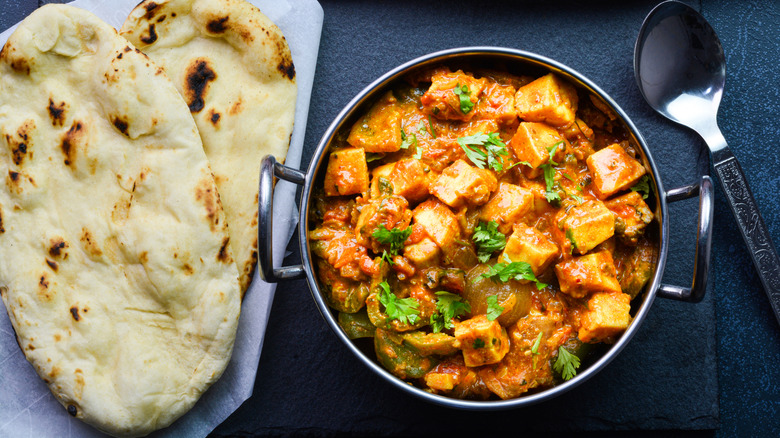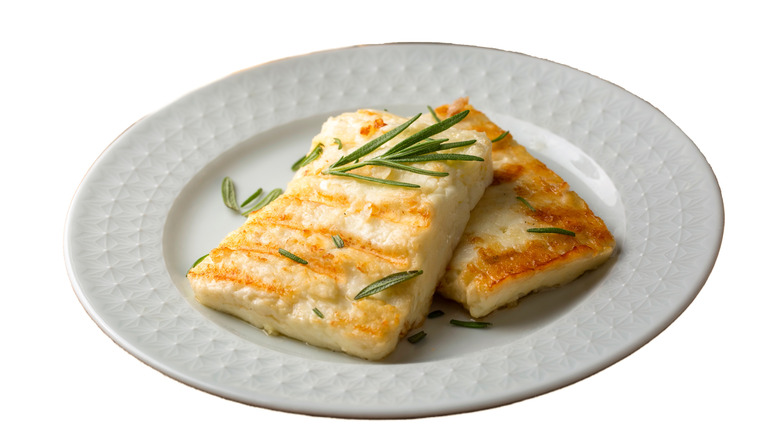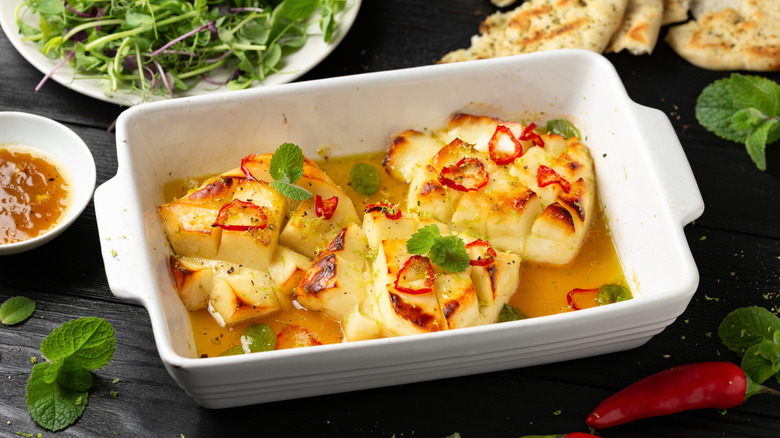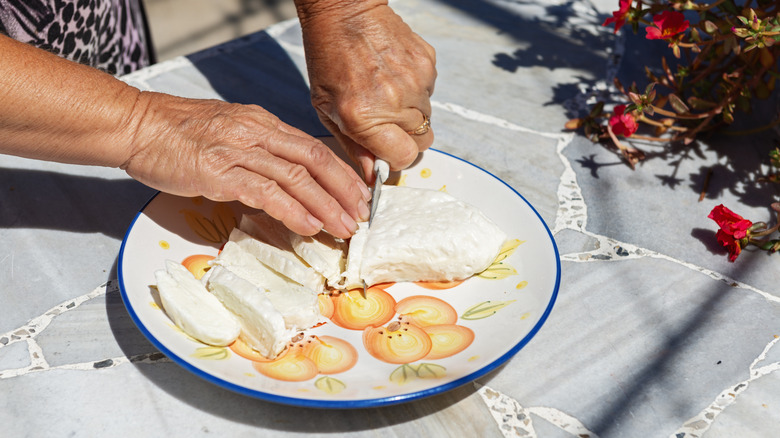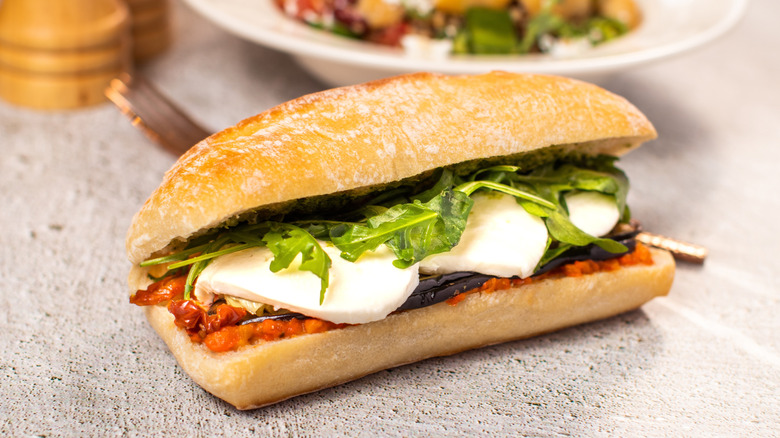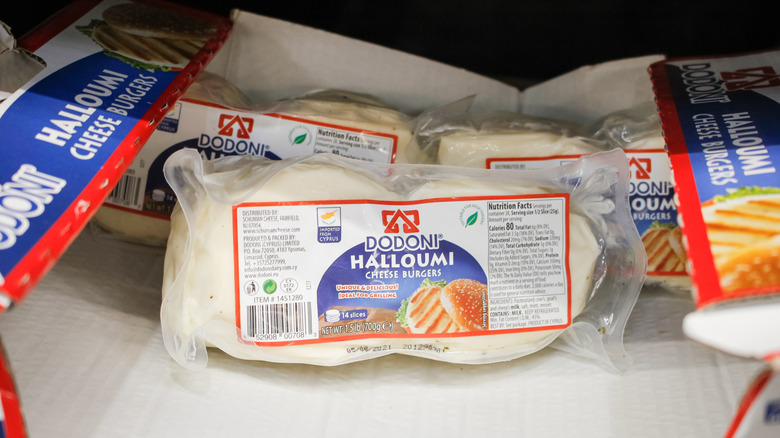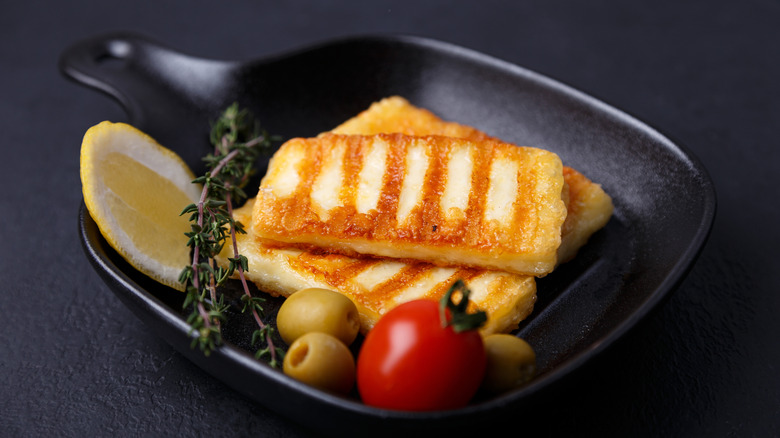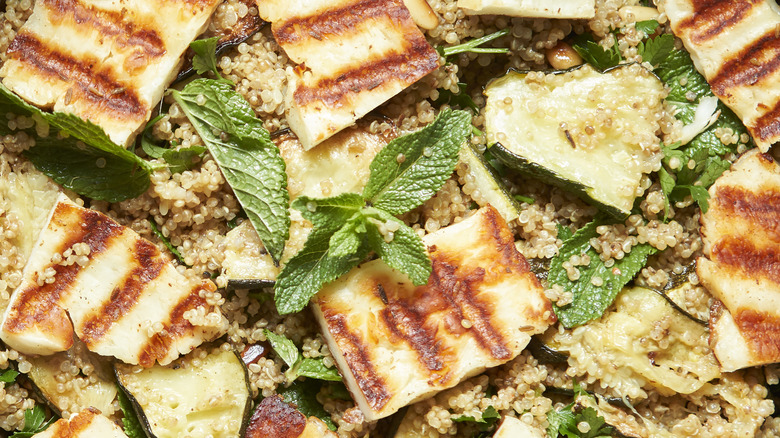What Is Halloumi And How It Is Different From Paneer?
Halloumi or hellim, its name in Turkish, is a traditional cheese from Cyprus with ancient origins reaching back to the Medieval Byzantine period. It is also made in other areas, especially in the Middle East. Deeply tied to Cypriot culture, it was originally made with only sheep's or goat's milk with methods passed down from generation to generation. Halloumi is a fresh, white, semi-firm cheese with a smooth, rubbery, or squeaky texture. It has the singular characteristic of keeping its shape when fried or grilled because of its especially high melting point. Consider visiting a city in Cyprus, a beautiful Mediterranean island country, when planning a trip to the world's best food destination cities to taste this special cheese served in its original environment.
Halloumi has gained popularity in many parts of the world, especially in places with increased interest in vegetarian recipes. It's very popular in the U.K. and in Europe, but chefs worldwide cook with it. U.S. sales, on the other hand, account for only ten percent of the global halloumi market. The cheese is now made in many countries, often with 100% cow's milk, but because it has European PDO protection, only the Cyprus-made product can use the names halloumi or hellim in Europe.
For more information about halloumi, we've reached out to Jeff Adams, co-owner of Walla Walla Cheese Company in Milton-Freewater, Oregon, who makes artisan cheeses from local cows. Read on to learn more about this ancient, unique, and delicious cheese and how to serve it at home.
What is halloumi?
Halloumi is a traditional cheese from Cyprus that has become popular around the world. It's a fresh cheese with a unique rubbery texture that squeaks when you bite into it, leading some producers to call it squeaky cheese. Traditionally, Cypriot halloumi was made with sheep's or goat's milk, or a mixture of the two, but now cow's milk is allowed to be added in a minority proportion. Versions made from sheep's or goat's milk have a stronger, tarter, and saltier flavor. Many modern producers in other parts of the world use cow's milk, and this results in a milder, blander cheese.
What's also unique about halloumi is that it's a fresh cheese that's cooked, and the specific cooking process used causes certain reactions that strengthen the cheese's structure. The proteins become bound very tightly and stay that way, even when the cheese is heated up later. This gives it an especially high melting point. That means you can slice it and put it on the grill and it won't melt or lose its shape. It will get grill marks just like meat or vegetables. Jeff Adams says he loves doing demos with halloumi because people are surprised to see cheese fried or barbecued. Because of this quality, halloumi is a good replacement for meat in vegetarian dishes. Serve it with vegetables or grill a thick slice to place on a burger bun with your favorite toppings.
How is halloumi made?
Halloumi is an important part of the culinary culture of Cyprus. Originally, families would keep their own sheep or goats and make the cheese at home, with each generation preserving the original methods. Production is just as important in present-day Cyprus, and it's now made in many parts of the world, with some modern processes worked in.
Jeff Adams makes halloumi with Jersey cow's milk in Oregon and shares the process they use at his cheese company. They start by pasteurizing the milk, adding vegetarian rennet, and cutting the curd into large pieces. He points out they don't add enzymes at any point. After the curd is slowly cooked to 104 degrees Fahrenheit, they drain the whey off. Then they hoop the curd into basket truckle molds and, while they heat the whey to 180 degrees Fahrenheit, they flip and drain the curd a few times. Once the whey reaches the right temperature, they cook the curd in the heated whey. When it floats to the top of the vat, it's done. Then they return the cheese to basket molds and salt it on both sides.
"The cooking process causes the proteins to retract and strengthen," Adams explains. "Heat and salt kill acid-forming bacteria that weaken the cheese's structure." It's this strengthening that gives halloumi its uniquely high melting point. Adams vacuum seals his halloumi the next day after it cools but points out that the traditional Cypriot storage method is to place it in a salt brine solution.
Regulations surrounding halloumi
Regulations govern the use of the Greek name halloumi and the Turkish name hellim, which were registered with the European Commission in 2015 to protect the Cyprus-made cheese with the PDO (Protected Designation of Origin) label. Deviation from the traditional recipe is generally the reason Cyprus wants to protect its original product, which must be made from at least 51% sheep's or goat's milk. Industrially produced halloumi or versions made abroad often favor cow's milk. Because of the protection, cheese sold in the European Union that is made outside of Cyprus cannot be labeled halloumi.
Halloumi isn't as well-known in the U.S. as it is in other parts of the world, and production isn't high here, but even so, the government in Cyprus has registered the word halloumi as a trademark in this country. "It technically needs to be made in the region of Cyprus to be called halloumi," Jeff Adams says. He explains that similar cheeses made in other areas are often labeled with creative names such as frying cheese or Jersey frying cheese. Grilling cheese is another name to watch out for if you're looking for halloumi and can't find it.
Halloumi is widely found in Europe, however. In fact, it's as popular as cheddar in the U.K. You may find it labeled squeaky cheese in Britain. The colorful name refers to the sound produced when someone's teeth slide down the rubbery cheese when taking a bite.
How is halloumi different from paneer?
Some people may confuse halloumi with paneer because they share certain characteristics. They are both fresh, unaged cheeses that are cooked during production. They're smooth, white, semi-firm, and can be easily sliced. More importantly, they both have a high melting point and can be grilled and fried without losing their shape.
However, the two cheeses are not the same. While halloumi is a traditional Cypriot product and an important part of the culinary culture of Cyprus, paneer is an important Indian cheese commonly used in many recipes like palak paneer and paneer tikka masala. Like many ancient traditional products, the origins of paneer are unclear, but one theory posits that Persian and Afghani leaders brought it to Southeast Asia back in the 1500s.
There are differences in production methods as well. Adams explains: "Halloumi is coagulated and cooked at temperatures from 90 to 104 [degrees] Fahrenheit and then formed into truckles. It is then cooked in its own whey. Paneer milk is brought to the high temperature before coagulation takes place. Coagulation is done by fruit juice or another acid-forming substance such as vinegar [while] halloumi uses rennet. Paneer does not have the salt added in the way halloumi does." The lack of salt gives paneer a blander flavor.
Although halloumi and panner are different cheeses, they have many similarities. It can be hard to find these specific products in some areas. If you have a recipe that calls for halloumi and it's not available, you can substitute paneer.
What does halloumi taste like?
"Cyprus halloumi is usually made from goat or sheep milk or a combination of the two," Jeff Adams says. This makes a difference in terms of flavor. "The sheep/goat milk is much more tart, salty, and pungent," he explains. "Cow's milk halloumi is fairly mild."
Fresh halloumi that's not cooked as part of a dish's preparation retains a mild flavor and a taste reminiscent of fresh milk. This is because halloumi is made with rennet and is not mixed with enzymes (cultures), explains Adams. Versions that are stored in brine, as is the traditional way, are also a little salty because of the time spent sitting in the salty liquid. When halloumi is cooked, whether it's fried, seared in a pan, or tossed on the grill, the flavor and aroma become stronger. The texture also changes, getting softer and creamier, but the cheese will never lose its shape.
Adams points out the noticeable difference between cooked and uncooked halloumi: "When grilled it tastes like a delicious grilled cheese sandwich without the bread. We have a person from Costa Rica that does not cook our halloumi and said it tastes just like farmer's cheese back home." Farmer's cheese, made in slightly different ways around the world, is a soft, white, milky-tasting fresh cheese with a mild flavor. Add that to the list of fascinating thing about halloumi. It's almost like having two separate cheeses to enjoy, depending on whether you cook it or not.
Varieties of halloumi
As we've seen, traditional varieties of halloumi are made from sheep's or goat's milk and have a pungent, salty taste. Cow's milk varieties are milder but also creamier and less salty, which some people prefer. Check the label before purchase to see which kind of milk a piece of halloumi is made from. The milk also varies by country. Greek halloumi uses a mixture of sheep's and cow's milk and Turkish halloumi mostly uses cow's milk.
You can also find halloumi that has been ripened in brine. Jeff Adams says: "There are fresh and mature versions of the cheese. Fresh halloumi is milder with an elastic texture, and a milder less salty flavor. A mature halloumi stored in brine has a drier texture and a saltier flavor."
Historically, dried mint was sometimes used in the brine when curing traditional halloumi, and besides giving it flavor, the mint acted as a natural preservative. Mint and halloumi taste great together, and dried mint is still used to flavor Cypriot halloumi today. Modern recipes for halloumi worldwide often feature mint as well. Halloumi found on the market is often made in flavored versions with additional ingredients like garlic, oregano, basil, or chili. Smoked halloumi is another version that has a rich and smoky complexity. Whether additional flavor comes from the heat of chili, aromatic herbs, or wood smoke, these versions of halloumi have an additional depth of flavor that pairs well with the creamy cheese.
Traditional ways to serve halloumi
Halloumi is traditionally served in Cyprus as a fresh table cheese, and it's very good eaten plain. It's delicious served with vegetables or meat or in salads and sandwiches. "Traditionally halloumi is served with warm pita bread or alongside a salad of tomatoes, cucumbers, and olives," Jeff Adams notes. A Cypriot summertime dish is halloumi and cold watermelon, a sweet, savory, and very refreshing treat.
Although halloumi is often eaten cold, it's earned a reputation as one of the most unexpected foods you should be grilling because it doesn't melt on the heat. Sliced halloumi doesn't require any special preparation before being tossed on the grill or in the frying pan, but brush cow's milk versions with a little oil first. Since it doesn't contain as much fat, it won't naturally crisp up and brown as much. Grilling is simple; just watch it for a few minutes and take it off the heat as soon as it's browned.
Cypriots enjoy halloumi hot in a variety of ways. Grilled or fried halloumi, often served with scrambled eggs, olives, or bread, is a popular breakfast food. It's also served on toast, in soups, grated on pasta, and as a burger topping. Many pastries feature halloumi, including borek, a popular treat in countries like Cyprus and Turkey. It's made with a flaky dough and filled with ingredients like spinach, cheese, and potatoes. In Cyprus, halloumi is also eaten with lountza, or smoked pork loin, often served on a sandwich.
Other ways to cook with halloumi
Halloumi has become popular around the world and many chefs like to use it in creative ways that aren't traditional but are still delicious. "Halloumi can be fried, barbecued, [or] cubed for salads. It has a crunchy exterior and [a] melty squeaky interior. Some people slice it thin enough to resemble potato chips when done," Jeff Adams explains. He notes halloumi can also be topped with olive oil, honey, and fresh tomatoes.
There's no lack of creative ways to cook with this unique cheese. Use halloumi to upgrade your pasta salad, or create a Mediterranean twist on chicken salad by swapping halloumi for chicken. In the U.K., Brits fry halloumi in a pan until browned and use it in salads, in stir-fries, and on burgers. They even deep fry it just like French fries. In fact, halloumi fries are an occasional McDonald's menu item in the U.K. and are served with a tomato dipping sauce.
Try a halloumi, fig, and prosciutto salad, or cube it and include it in a quiche. Drizzle slices of grilled halloumi with a honey or balsamic vinegar glaze. Alternatively, use crispy grilled slices of halloumi as a rich, high-protein ingredient in a sandwich. Layer them with grilled eggplant, zucchini, or red peppers and serve it on a bun. Finally, warmed cubed or sliced halloumi can be a delicious addition to bruschetta, crostini, and toast toppings along with your favorite Mediterranean ingredients like olives, arugula, and basil.
Where to buy halloumi
Halloumi isn't as well-known in the U.S. as it is in Europe and other parts of the world. Jeff Adams says it can mainly be found in specialty cheese departments or cheese stores. Searching out local cheese makers like Adams can help you find artisan halloumi in your area. For example, Adams' company sells it in a very local area of the Northwest. Just have some patience because halloumi isn't as widely made here.
Apart from purchasing it from local makers, halloumi can be found in international food stores, and you can find a limited selection in some regular supermarkets. You may find it in shops or small grocery stores if you live in a city with a strong Cypriot, Greek, or Turkish presence. Most of the halloumi sold in this country is imported, mostly from Europe (especially Cyprus) and the Middle East. That makes it not only harder to find, but expensive. However, imported halloumi is your best bet if you're looking for a traditional product made with sheep's or goat's milk, which isn't widely used in the U.S. Grab some frying cheese, grilling cheese, or squeaky cheese if you see it, because it's a similar product. Just know that mass-produced halloumi is probably made with cow's milk and tastes a little different.
Nutritional information about halloumi
Just one ounce, or 28 grams, of halloumi has 110 calories, seven grams of protein, and 25% of the daily value for calcium. It also has nine grams of fat and 350 milligrams of sodium (or 15% of the daily value). Halloumi can be considered a healthy food because of its protein and calcium content. Consuming the right amount of these two nutrients is important for health. Protein helps with the proper function of the endocrine system and the immune system, and aids tissue growth, muscle recovery, and the retention of lean body mass when dieting. Calcium is important for bone health, increasing bone density and lowering the risk of fractures.
However, halloumi is a cheese, and like cheese in general, it's high in fat and sodium so it's best consumed in moderation. Keeping serving sizes small is one way to enjoy it healthily. Instead of serving it as a main dish or eating it alone, combine it with plenty of vegetables or whole grains. Try crumbling it on a salad or using small cubes of grilled halloumi as a flavor-packed topping. Consider combining halloumi with a different source of protein, like beans or legumes, to get a higher amount of protein in your meal without increasing its fat and sodium content. Beans are an important part of the Mediterranean diet, so they can easily be incorporated into many recipes that call for halloumi.
How to store halloumi
Halloumi has a long history, and in the times before refrigeration, it was stored in a jar and covered in olive oil. Today it's sold in vacuum-packed wrappings or in brine. Choose properly sealed, firm pieces that have a white or off-white color. Jeff Adams says that properly packaged halloumi will last for a year if it's kept refrigerated. After opening it, store the halloumi in an airtight container in the refrigerator.
How long it will last can vary. Opened halloumi should be consumed within one to two weeks. The cheese should be tightly wrapped or placed in a brine, because the salt solution helps preserve it. In fact, Cypriots make something they call old cheese by carefully and tightly packing halloumi in brine in an airtight container, where it will last for up to four months if the brine is properly salty. The name refers to the fact that the outside hardens when this method is used. Adams notes that the flavor of halloumi stored in brine changes because it will keep getting saltier and tarter.
Halloumi should smell fresh and salty. If you note an unpleasant or altered smell, a change in color, dryness, or mold, the cheese is no longer safe to consume. You can freeze halloumi if you need to store it safely for longer. It will be good to eat once defrosted, although Adams says that it will have an altered texture and lack the fresh squeaky taste of unfrozen pieces.
